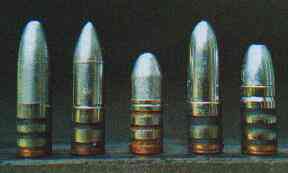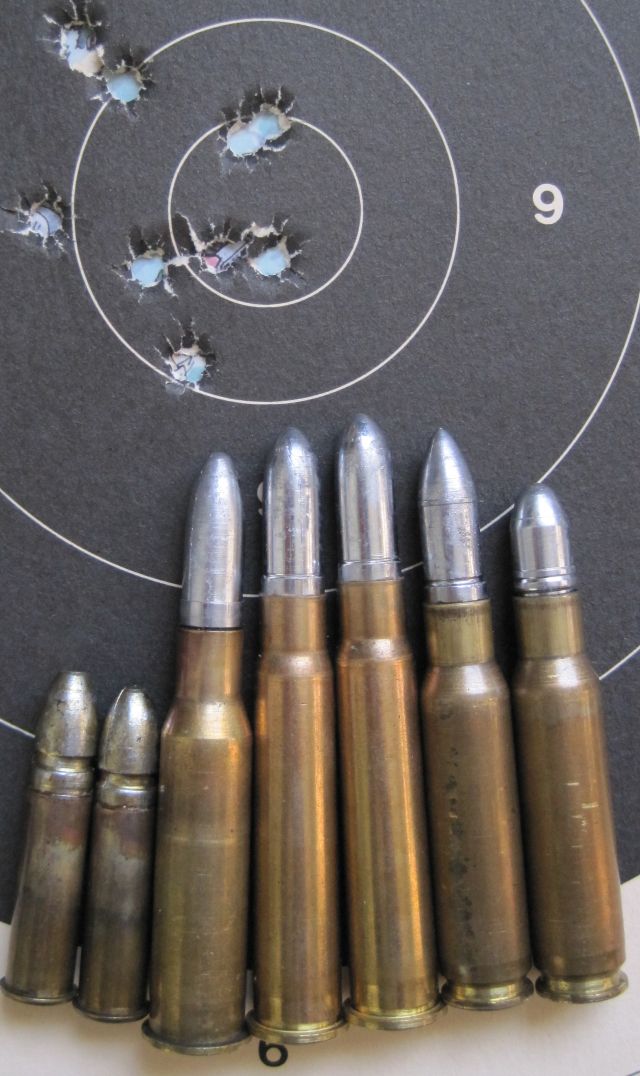On the other hand, use of cast or swaged lead bullets in rifles ceased in the last Quarter of the 19th Century, so reloading 20th Century rifle calibres with lead bullets is rare in Britain and much more difficult. The need to have cast lead bullets closely matched to the size of the barrel throat is not appreciated by those attempting to reload for the first time and neither is the use of hard alloys and special lubricants. As a result of poor bullet fit, wrong alloy and lubrication, accuracy with cast lead bullets in modern rifles can be disappointing. Consequently there is a common misconception amongst British target rifle shooters that lead bullets are so inacurate as to be unsuitable for reloading modern rifle cartridges originally designed for jacketed bullets.
Whilst it is true that cast lead bullets cannot duplicate the jacketed bullets ballistics, provided the loads are within the cast bullet limitations accuracy will be comparable over the ranges at which the lead bullet remains supersonic. My experience is mainly with 7.62NATO and 303British calibres of which the latter can be especially difficult to reload.
Barrel throat, bore and groove diameters
SMLE and No.4 Enfield rifles are in plentiful supply and are the obvious choice for the increasingly popular Classic and Veteran service rifle matches. Unfortunately, both rifles have been produced at various arsenals scattered all over the former British Empire and in addition many have been made under wartime conditions. Consequently, barrel groove sizes vary from .312" to .318" and may thus require bullet moulds and dies made to special order to ensure good bullet fit.
So, the first difficulty that the prospective cast bullet shooter encounters is at the point of puchase of a rifle. Whilst many dealers can be relied upon to provide information on the rifle's type, year of manufacture and even service history, most are unable to offer any help as regards measuring the barrel's vital statistics and the usual response to the question about the grove or bore size is "standard", which means that the trader does not really know.
This sad state of affairs has prompted me to share my experience with other shooters. The No.4 Enfield that I bought was a recent factory rebuild, so I was sure that it had a new barrel, new wood and a new magasine. I learned later that the barrel was an oversize one (groove diameter .316") and getting it to shoot well cost me more than the rifle itself. Hopefully, sharing my experience with you will prevent that happening to you.
So, if you are contemplating loading cast lead alloy bullets, the first stage is to slug the barrel and measure accurately the diameter of the throat, grove, bore and chamber neck.
This is a vital first stage of the bullet selection process and it is quite easy to do. Proceed as follows. Take a case that has been fired in your rifle, cut the neck at the shoulder and fill it with lead. You will also need a soft lead plug (photo on left) a steel rod a few inches longer than your rifle's barrel and a light hammer.
Chamber the case and close the bolt. Insert the soft lead plug into the muzzle and drive it down carefully with the rod and hammer. Keep hitting the end of the rod until you feel the hammer bounce. That is the sign that the plug has reached the bottom and has expanded to take up all the available space. Then, open the bolt, remove the case and gently tap out the plug. You now have a "chamber cast" of your rifle. This is shown in the photograph on the right - the plug has been placed on top of the case to illustrate the point.
Measure carefully the diameter of the chamber slug immediately in front of the chamber neck. This is the throat and if it tapers it is the smaller end of the taper that is critical. In order to get optimum accuracy the bearing bands of the bullet must be either the same as the throat or not more than .0005" smaller (+0,-.0005") Measure also the diameter of the chamber "neck" and the diameter of the bore. The method I used to estimate the size of the bore is to push a tight fitting bullet into the muzzle, turn it a few times and them measure across the "rub" marks.
The size of the chamber throat can become a limiting factor if you are using oversize bullets. The bore size is not critical, but if you are going to use long nosed bullets it is important that they ride the bore and to ensure that the diameter of the bullet nose must either the same or slightly larger than the bore.
 The photograph on the left shows the bullets that I use. From left to right: Lyman 314299, Lyman 311334 with centering ring, Lee C309-160R, NEI #85A and NEI #85.
The photograph on the left shows the bullets that I use. From left to right: Lyman 314299, Lyman 311334 with centering ring, Lee C309-160R, NEI #85A and NEI #85.
It is advisable not to spend money on moulds, sizer dies etc. until you have slugged the barrel as described above. You should also do some research to find the "nominal" dimensions of your chamber and throat, especially if the calibre you intend to load for has not being made to SAAMI standards.
When I slugged and measured the vital statistics of my No. 4 Enfield I realised immediately that I had an oversize barrel. The throat was .317", groove .316" and bore .304". When I consulted every available catalogue, I came to the conclusion that almost nothing I needed was available off the shelf and that I was, therefore facing two options. Either take the expensive "special order" route, or, probably even more expensive re-barrelling of the rifle.
I considering my options I could not rely on local advice and guidance because (a) shooting cast lead bullets in relatively modern military calibres is still very rare in UK and (b) many specialist gunmakers have been forced to close following the handgun ban in 1997.
I decided not to rebarrel, but to attempt to achieve accuracy with cast bullets tailor made for my rifle, which started me on the "special order" route as nothing I wanted was available off the shelf. A word of caution is appropriate at this point. Your task will be made much easier if you have access to Internet, because prior to ordering dies and reloading equipment much research is necessary to ensure success. I would recommend the membership of Cast Bullet Association where you can discuss your specific problems and obtain invaluable advice before buying equipment and tools. If you are living outside USA you will also have to ensure that the suppliers of your choice are prepared to export and have facilities to do so.
To make your task easier I shall be giving you direct links to the sources that I used. Their services and quality of goods were excellent, but please note that I am in no way connected with any of them and that there are others providing equally good products and services.
Unfortunately, I was not able to find a single source for all my needs, so I placed orders on Internet as follows:-
Bullet Mould NEI Handtools, Inc.
Sizing G&H die Huntingtons
Case Neck Expander CH-4D
 It became necessary to outside neck turn cases of certain brands and this can be clearly seen it the photograph of the loaded rounds on the right. With the exception of the round on the left, which is a jacketed bullet, the other two show the cutting marks on their necks.
It became necessary to outside neck turn cases of certain brands and this can be clearly seen it the photograph of the loaded rounds on the right. With the exception of the round on the left, which is a jacketed bullet, the other two show the cutting marks on their necks.